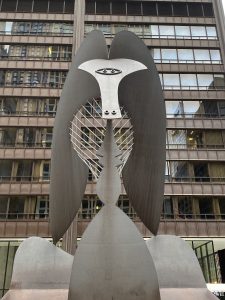
The Chicago Picasso in Daley Plaza, copyright 2023 Harshman Ponist Smith & Rayl
Lawyers and others often say that “may” is permissive and “shall” is mandatory. By that, they mean that when a statute says a person “may” do something, that person has the discretion to do it or not, but when a statute says a person “shall” do something, the person has no choice. Or, as the Drafting Manual for the Indiana General Assembly puts it:
To create a duty, say “shall.”
For example, “A member shall seek reimbursement for expenses” means that the member is commanded or directed to seek recovery of the reimbursement.
However, merely creating a duty to act does not answer the question, what happens if that duty is not satisfied? To expand on the above example, what happens if the statute says, “A member shall seek reimbursement for expenses within 30 days of incurring the expense,” but the member does not seek reimbursement until 60 days after incurring the expense? Has the member forfeited the right to reimbursement? Or to put it another way, is the failure to seek reimbursement before the prescribed deadline procedurally fatal?
Mandatory and Directory Statutes
Courts have divided statutes that create a duty to act into two categories: mandatory and directory. Unfortunately, those terms are not self-explanatory. The difference between them is the consequence of the failure to act. Failure to comply with a mandatory statute is procedurally fatal. If the statute in our hypothetical example is deemed to be mandatory, a member who does not seek reimbursement within 30 days loses the right to reimbursement.
On the other hand, failure to comply with a directory statute is not procedurally fatal. In our hypothetical example, if the statute is directory, the member does not lose the right to reimbursement even if he does not seek it until after the 30-day deadline.
If both mandatory and directory statutes use the word “shall,” how can one tell them apart? As illustrated by Terrault v. Scheere, No. 22A-22-914 (Ind. Ct. App. Dec. 15, 2022), there is no bright-line rule.
Disputed Ownership of a Prototype of the Chicago Picasso
In Terrault v. Scheere, the difference between mandatory and directory statutes determined which of two putative buyers of a wooden prototype of a Picasso sculpture actually owned it.
The prototype is a one-quarter scale model of the Chicago Picasso, a 50-foot sculpture in Daley Plaza designed by famed artist Pablo Picasso. The Chicago Picasso was fabricated in Gary, Indiana, by American Bridge Company, a division of U.S. Steel. American Bridge created the model from Pablo Picasso’s design to serve as an aid to the workers who made the full scale sculpture. The City of Chicago unveiled the sculpture in 1967, and in 1970, American Bridge donated the model to Gary Community Schools.
In 2019, the emergency manager that had been placed in control of Gary Community School Corporation offered the model for sale at auction. The successful bidder was Jean-Christophe Scheere of Belgium. A few days after the auction, the emergency manager realized it had not notified the mayor of Gary of the sale as required by the statute that establishes the emergency manager’s authority:
An emergency manager’s power, authority, and responsibilities include the following:
…
Selling assets … of the distressed political subdivision…. In the case of an emergency manager appointed for the Gary Community School Corporation, the emergency manager shall provide written notice to the mayor of the city of Gary at least thirty (30) days before selling assets under this subdivision.
Ind. Code § 6-1.1-20.3-8.5(b).
Believing the sale to Scheere to be invalid, the emergency manager notified the mayor of the intent to sell the model and caused the publication of a notice that additional bids would be accepted. After the 30-day notice period closed, the emergency manager sold the model to Terrault, who had outbid Scheere.
Scheere sued, arguing that, despite the emergency manager’s failure to notify the mayor, the original sale to him was valid and that he acquired ownership of the model when the bidding first closed. Therefore, Terrault acquired nothing when the emergency manager purportedly sold the model to him because the School Corporation no longer owned the model. On partial summary judgment, the trial court agreed with Scheere. Both Terrault and the School Corporation appealed.
The Court of Appeals agreed with the trial court, holding that the emergency manager’s duty to notify the mayor was directory, not mandatory, and that the failure to fulfill that duty was not fatal to the emergency manager’s authority to sell the model to Scheere.
Although a statute using “shall” is generally considered mandatory, phraseology is not the be-all and end-all. If a statute is subject to more than one interpretation, the court will ascertain legislative intent and apply the statute to the facts accordingly, considering the statute’s design and nature, as well as the consequences that flow from different interpretations. The Court of Appeals found that the following factors showed that the Indiana General Assembly intended the notice requirement to be directory rather than mandatory.
- The statute provides no negative consequences if the mayor is not notified.
- In particular, it does not provide that a sale without notice is invalid.
- Nothing prohibits the emergency manager from completing the sale if the mayor objects, either before or after conferring with the emergency manager.
- A mandatory interpretation would frustrate the broad authority the statute vests in the emergency manager to control the School Corporation’s financial affairs.
The court of appeals affirmed the trial court’s decision in all respects and returned the case to the trial court to adjudicate matters not resolved on summary judgment.
A side note: Not the Wooden Model’s First Rodeo

View of the Chicago Picasso from underneath the sculpture showing the wings. Copyright 2023 Harshman Ponist Smith & Rayl, LLC
The wooden prototype played a role in another legal dispute before Terrault v. Scheere. In 1967, the City of Chicago conducted a publicity campaign to raise money to fund the construction of the Picasso sculpture. During the campaign, American Bridge invited the press to its facility in Gary and put the model on display. After that event, Fortune magazine published a three-page article that included a photograph of the model.
In 1970 the U.S. District Court for the Northern District of Illinois held that the copyright to the design of the Chicago Picasso was invalid. At the time, U.S. copyright law required the first publication of a copyrighted work to be accompanied by a copyright notice, typically the symbol © followed by the date of first publication and the name of the copyright owner. The Northern District held that the copyright, which Picasso had assigned to the City of Chicago, was no longer valid because the City had, on several occasions, published the design without the copyright notice. One of those occasions was the event in Gary when members of the press were permitted to view and photograph the model. The case is Letter Edged in Black Press, Inc. v. Public Building Commission of Chicago, 320 F. Supp. 1303 (N.D. Ill. 1970).
To subscribe to this blog, look for the Subscribe button on the right side of this page.
Disclosure
Harshman Ponist attorneys Michael Smith, Morgan Brading, Susan Rayl, and Rachelle Ponist of Harshman Ponist represent Scheere at the trial level. Attorneys Smith and Brading represented him on appeal.
 Indiana Business Law Blog
Indiana Business Law Blog

